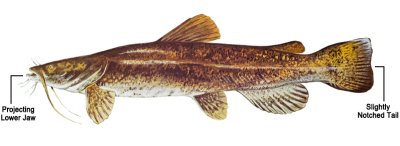

Illustrations of the Flathead Catfish (top) and the Blue Catfish. (Source: Md. Dept. of Natural Resources)
ANNAPOLIS—The Maryland Department of Natural Resources on April 10 launched a statewide campaign to educate citizens about invasive Blue and Flathead Catfish – their impact on native species and what anglers can do to help. Partners and stakeholders joined DNR staff at Smallwood State Park on the Potomac River for a catfish cooking demonstration and tasting to kick off the effort.
“Increasing in population and range, both Blue and Flathead Catfish are now abundant in the Chesapeake Bay, threatening the natural food chain of our ecosystem and causing concern among fishery managers,” said DNR Deputy Secretary Frank Dawson.
DNR developed the outreach program to help anglers identify and catch these invasive species, understand the importance of regulations that prohibit their transport, and encourage anglers to keep the fish instead of releasing them alive.
“Blue and Flathead Catfish are long-lived voracious predators. They grow to enormous size, have many offspring and dominate other fish populations wherever they take hold,” said DNR Fisheries Service Director Tom O’Connell. “We want everyone to be aware of this significant problem and to know that it is illegal to transport these fish between bodies of water in Maryland.”
The Chesapeake Bay Program’s Sustainable Fisheries Goal Implementation Team and the Atlantic States Marine Fisheries Commission have both formerly recognized the need to address the threat to native species by working to reduce invasive catfish densities and range.
“Increasing public awareness of Blue and Flathead Catfish and the effects they have on the ecosystem is critical, so we’re pleased that Maryland is taking important steps to help educate the public not only about those fish but about what they can do to help,” said Peyton Robertson, director of the NOAA Chesapeake Bay Office, and Goal Implementation Team Chair.
In addition to establishing more than 150 educational/cautionary signs at water access points and kiosks statewide, the State is escalating efforts to market Maryland’s fledgling commercial catfish fishery. Catfish dishes from Chef Michael Stavlas of Hellas restaurant in Millersville and Executive Chef James Barrett of Azure in Annapolis provided attendees with a taste of this delicious invader.
“The marketing of Blue Catfish is a win-win for Maryland’s seafood industry. It promotes anglers catching ? and restaurants serving ? fish with no seasonal regulations, while reducing the pressure on native species,” said Maryland Seafood Marketing Director Steve Vilnit. “These fish have already found their way to hundreds of area menus, and Whole Foods Market and the Clyde’s restaurant chain have committed to add them to their offerings.”
“We are pleased to help restore balance in the Chesapeake Bay’s ecosystem by selling wild Blue Catfish to institutions and restaurants at a competitive market price,” said Wendy Stuart of the Wide Net Project, which also supports the effort. “We then take our commitment to the region a step further, with proceeds from the sales supporting local hunger relief and environmental education.”
Blue and Flathead Catfish were introduced into the Chesapeake Bay ecosystem in the 1970s and 80s. Flatheads found ideal conditions in the OccoquanRiver, a small tidal Potomac tributary in Virginia and were recently identified in the non-tidal Potomac River near Williamsport. Flatheads have also become established in the Lower Susquehanna River. Blue Catfish are now in most of the major tributaries of the Chesapeake Bay as a result of their natural range expansion and possibly through illegal introductions by fishermen seeking to establish fisheries in other waters.
There is no limit to the number of catfish an angler can catch and keep. The Maryland Department of the Environment advises limiting monthly Blue Catfish consumption for adults to: four fish under 15 inches; two between 15 and 24 inches; or one between 24 and 30 inches; and none over 30 inches due to the possibility of chemical accumulation in these species. The recommended monthly limit for children is: four under 15 inches; one from 15 to 24 inches; one fish every other month from 24 to 30 inches; and none over 30 inches.
To report any suspicion of illegal transport of live invasive species in Maryland call 800-635-6124. The fine for breaking this law by moving live blue and flathead catfish is up to $1,000.
For more information on invasive species in Maryland, visit dnr.maryland.gov/invasives.
Source: Md. Dept. of Natural Resources


